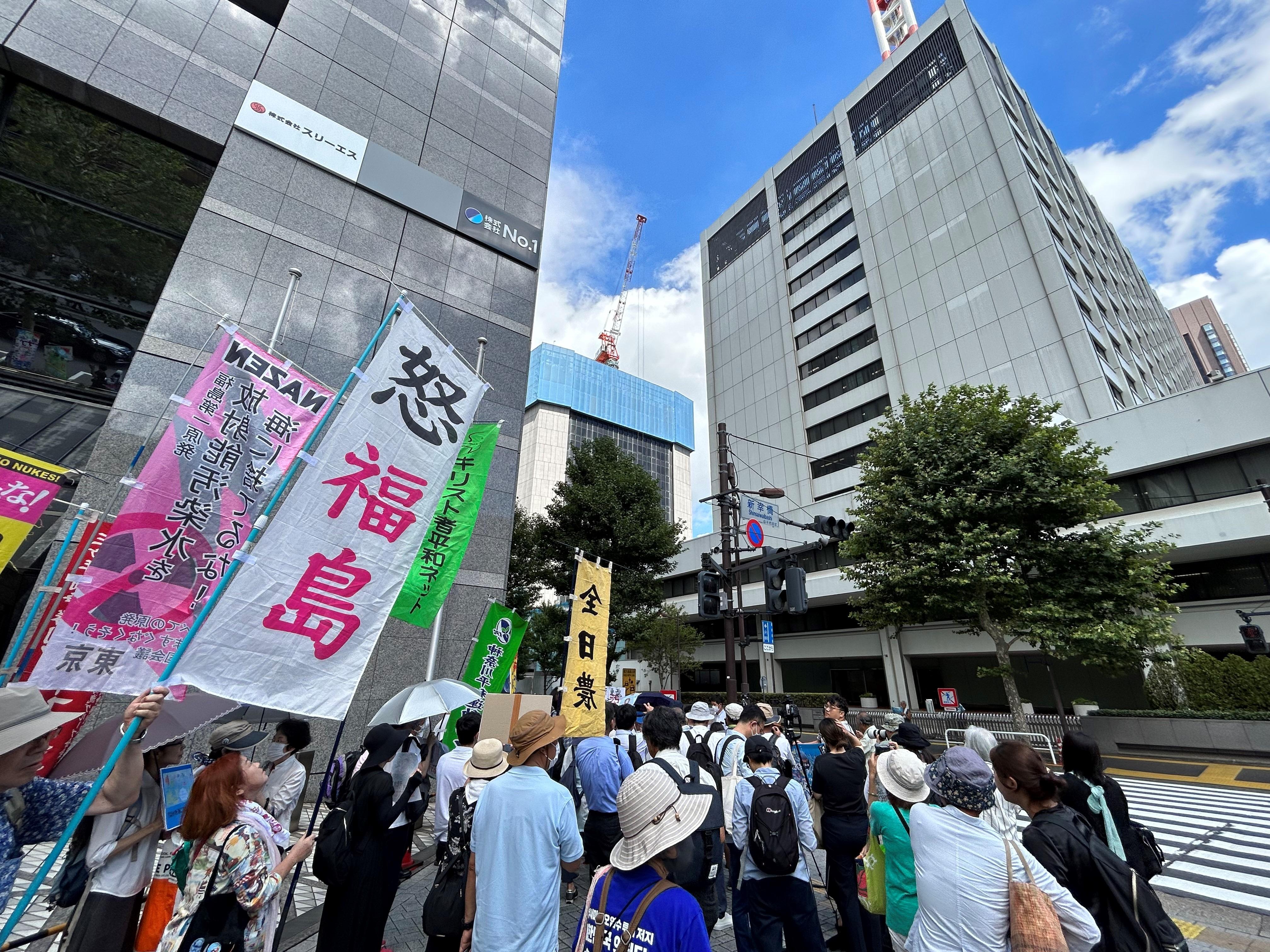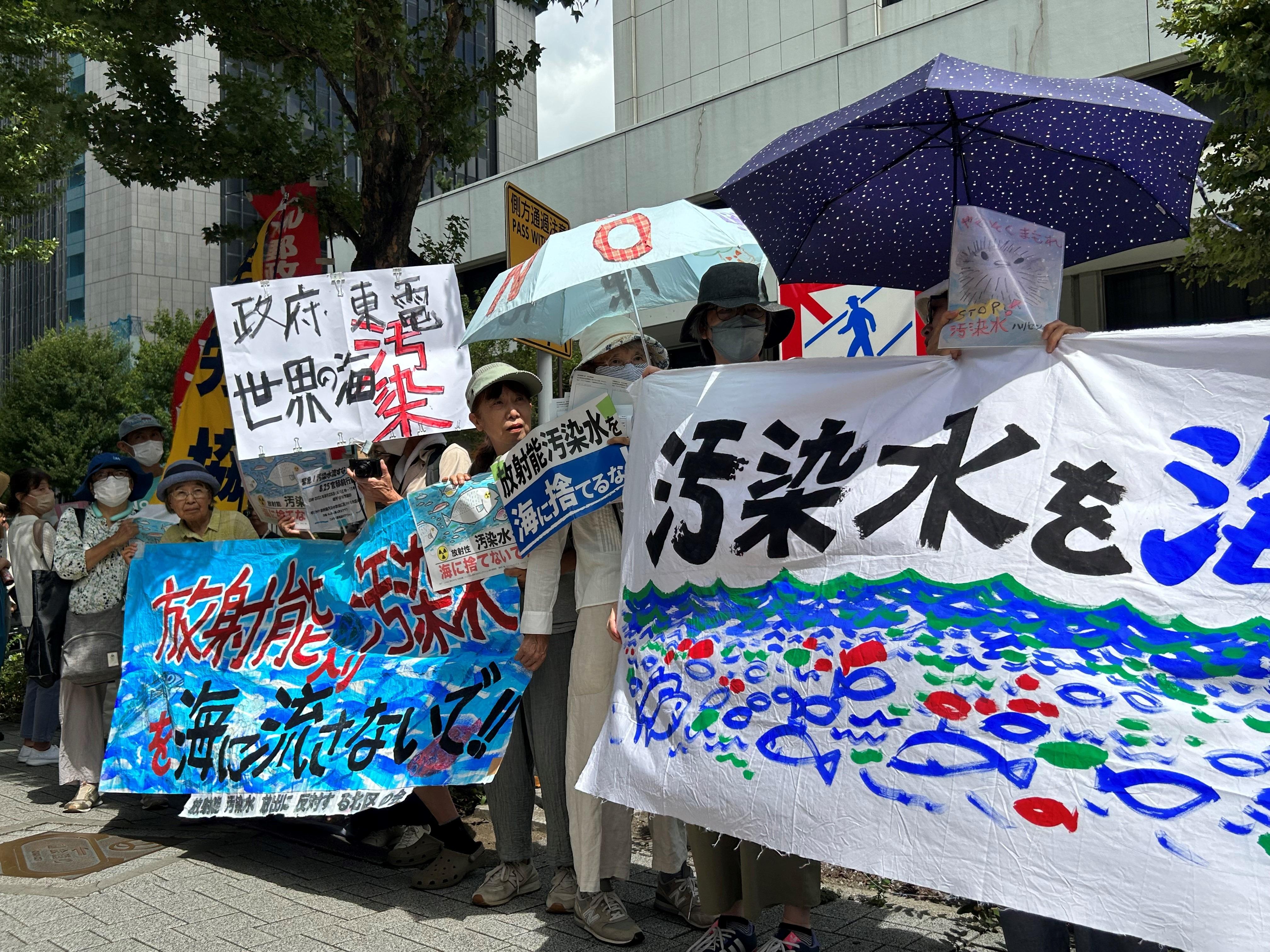 The Fukushima Daiichi Nuclear Power Plant is seen from the nearby Ukedo fishing port in Namie town, northeastern Japan, Aug 24, 2023. (PHOTO / AP)
The Fukushima Daiichi Nuclear Power Plant is seen from the nearby Ukedo fishing port in Namie town, northeastern Japan, Aug 24, 2023. (PHOTO / AP)
TOKYO - Japan has started releasing nuclear-contaminated wastewater from the crippled Fukushima Daiichi Nuclear Power Plant into the Pacific Ocean on Thursday, while hundreds of Japanese gathered in central Tokyo to rally against the discharge plan.
Live video provided by the plant operator Tokyo Electric Power Company (TEPCO) showed that a staff member turned on a seawater pump at around 1:00 pm local time (0400 GMT), marking the beginning of the controversial ocean discharge, while concerns and opposition persisted among local fishermen as well as in neighboring countries and Pacific island countries.
The radioactive wastewater has been diluted as planned before being discharged via an underwater tunnel 1 km from the plant, according to TEPCO.
Under scorching heat, Japanese civic groups rallied in front of the headquarters of TEPCO as well as in Fukushima, urging the Japanese government and TEPCO to halt the discharge of nuclear-contaminated water immediately
Under scorching heat, Japanese civic groups rallied in front of the headquarters of TEPCO as well as in Fukushima, urging the Japanese government and TEPCO to halt the discharge of nuclear-contaminated water immediately.
Tokyo protesters condemned Prime Minister Fumio Kishida’s administration for disregarding the written commitment that “no disposal of contaminated water without understanding of the parties involved” with the fishing industry and ignoring the voices of Fukushima prefectural residents, as well as the voices of citizens from countries connected by the sea.
ALSO READ: Fukushima water: Japan urged to rethink its plan as concerns mount
“This forceful and autocratic approach leaves one speechless,” said a representative of KOREUMI, a Japanese citizens’ conference to condemn further pollution of the ocean. “They proceeded without pausing for discussion, determined to discharge at all costs, which is markedly undemocratic.”
Protesters said letting nuclear-contaminated water flow into the ocean is a selfish and weak behav-ior that should never be allowed. They believe that this issue has already become an international problem and all humans on Earth are stakeholders.
In Fukushima prefecture, a group of residents and lawyers opposing the discharge held a news con-ference in Iwaki, Fukushima prefecture on Wednesday. There were also local protests on Thursday.
They announced the intention of local residents and fishermen to file a lawsuit at the Fukushima District Court on Sept 8, seeking the cancellation of the Nuclear Regulation Authority’s approval of the ocean discharge plan and demanding TEPCO to cease the release.
 Japanese civic groups hold a rally in front of the headquarters of Tokyo Electric Power Company in Tokyo on Aug 24, 2023, urging the Japanese government and TEPCO to halt the discharge of nuclear-contaminated water immediately. (JIANG XUEQING / CHINA DAILY)
Japanese civic groups hold a rally in front of the headquarters of Tokyo Electric Power Company in Tokyo on Aug 24, 2023, urging the Japanese government and TEPCO to halt the discharge of nuclear-contaminated water immediately. (JIANG XUEQING / CHINA DAILY)
We, as the agricultural cooperative, cannot allow such destructive actions by TEPCO. Even if we have been deceived for the time being, we must stop the ocean discharge as soon as possible.
Taeko Fujimura, Member of Japan's National Federation of Agricultural Cooperative Associations
Taeko Fujimura with Japan's National Federation of Agricultural Cooperative Associations, also known as Zen-Noh, said the ocean discharge "cannot be forgiven" and was "extremely unreasonable."
READ MORE: Japan must pay for radioactive water damage
"Have you now obtained the understanding of the relevant parties? Have you properly explained your actions to them?" Fujimura shouted the questions amid the crowd of protesters.
The Zen-Noh official told Xinhua that in Zen-Noh's previous talks with TEPCO, it clearly stated that apart from tritium, there are various other radioactive substances that will remain in the tainted water in large amounts even after the second round of ALPS treatment.
Fujimura stressed that the ocean discharge, which is to continue for at least 30 years, will cause significant environmental damage. "It will pollute the sea, the marine life within it, the environment, and the Earth."
"We, as the agricultural cooperative, cannot allow such destructive actions by TEPCO. Even if we have been deceived for the time being, we must stop the ocean discharge as soon as possible," she added.
 Japanese civic groups hold a rally in front of the headquarters of Tokyo Electric Power Company in Tokyo on Aug 24, 2023, urging the Japanese government and TEPCO to halt the discharge of nuclear-contaminated water immediately. (JIANG XUEQING / CHINA DAILY)
Japanese civic groups hold a rally in front of the headquarters of Tokyo Electric Power Company in Tokyo on Aug 24, 2023, urging the Japanese government and TEPCO to halt the discharge of nuclear-contaminated water immediately. (JIANG XUEQING / CHINA DAILY)
Among the protesters was Sachiko Uno, who told Xinhua that she came to "stop them from polluting the ocean."
READ MORE: Fukushima discharge plan 'terror' act, says S. Korean opp
"One of the world's top-level nuclear accidents occurred in Fukushima despite safety promises made by the government and TEPCO. Now, they have become the world's first by beginning to discharge nuclear-contaminated water into the ocean. This is a 'double damage,'" said the 73-year-old woman.
Uno is also concerned with TEPCO's credibility. "It says the radioactivity concentration in the nuclear-contaminated water meets the standards, but I can't believe that at all. The reliability of the measuring instruments themselves is questionable," she said.
 Japanese civic groups hold a rally in front of the headquarters of Tokyo Electric Power Company in Tokyo on Aug 24, 2023, urging the Japanese government and TEPCO to halt the discharge of nuclear-contaminated water immediately. (JIANG XUEQING / CHINA DAILY)
Japanese civic groups hold a rally in front of the headquarters of Tokyo Electric Power Company in Tokyo on Aug 24, 2023, urging the Japanese government and TEPCO to halt the discharge of nuclear-contaminated water immediately. (JIANG XUEQING / CHINA DAILY)
Hit by a magnitude-9.0 earthquake and an ensuing tsunami on March 11, 2011, the Fukushima plant suffered core meltdowns that released radiation, resulting in a level-7 nuclear accident, the highest on the International Nuclear and Radiological Event Scale.
The plant has been generating a massive amount of water tainted with radioactive substances from cooling down the nuclear fuel in the reactor buildings, which are now being stored in about 1,000 storage tanks.
READ MORE: China condemns Japan's nuclear contamination dumping
TEPCO said it plans to carry out the first round of release over the next 17 days to discharge 7,800 tons of the radioactive wastewater.
In the current fiscal year through next March, a total of 31,200 tons are slated for discharge, equivalent to the storage capacity of 30 tanks, TEPCO added.
With Xinhua inputs
jiangxueqing@chinadaily.com.cn


